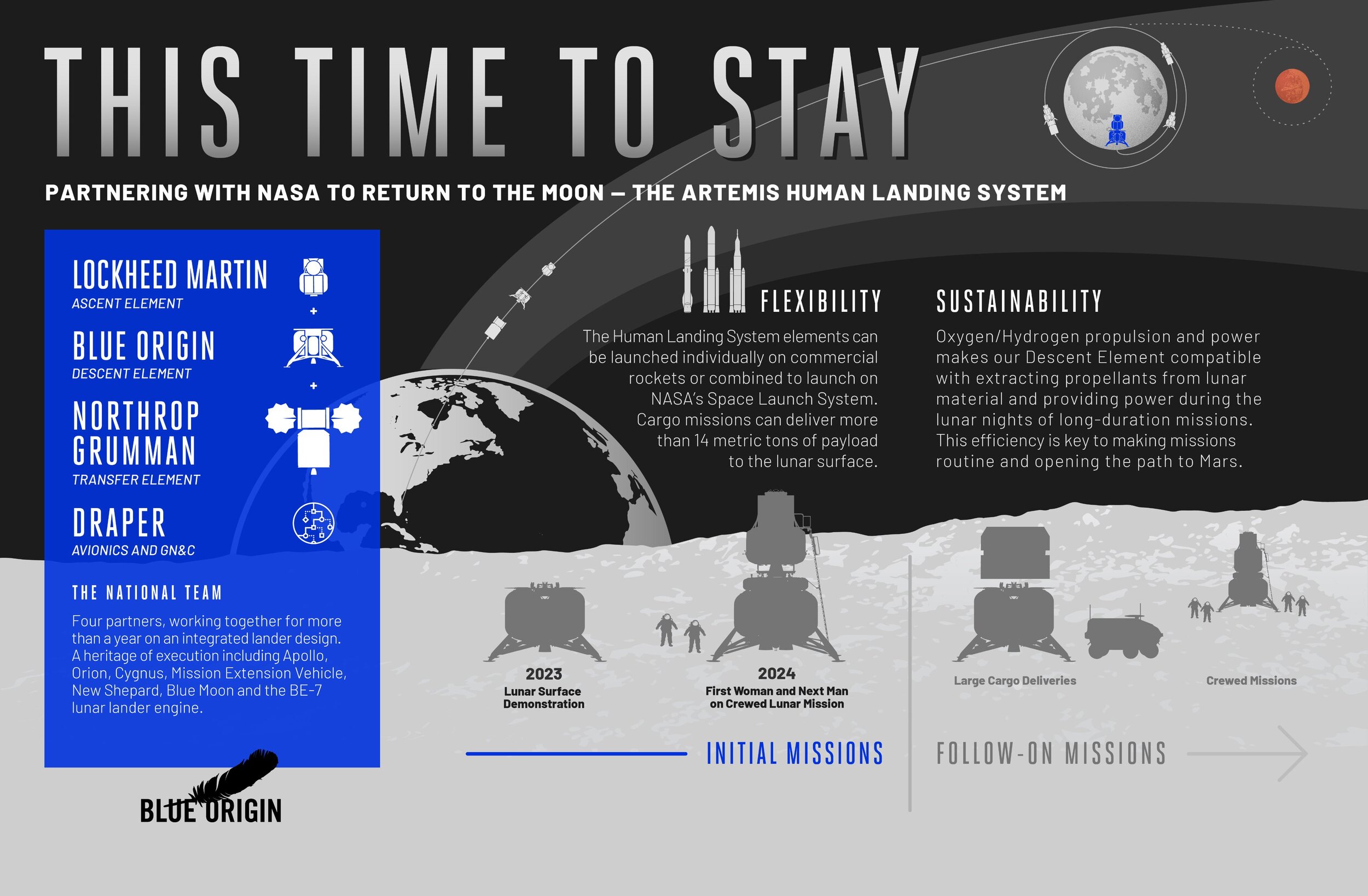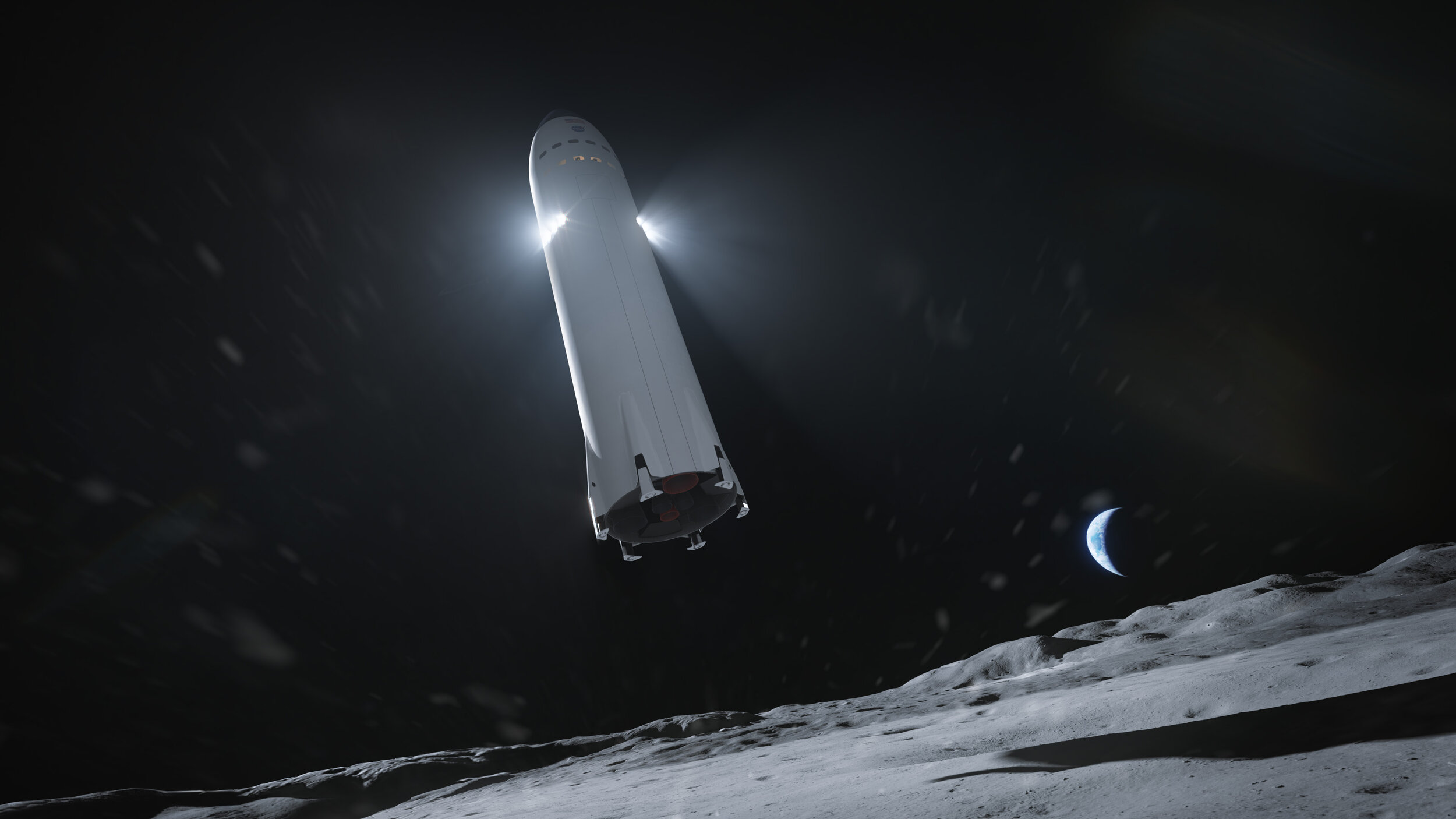NASA awards contracts for human-rated Moon landers
/Just over a year after the announcement of the Artemis program and its goal to return humans to the surface of the Moon by 2024, NASA has finally awarded the initial contracts for the most important piece of architecture to achieve that goal: human landing systems. These are the first contracts to build human-rated lunar landers since the Apollo era.
During an April 30, 2020, audio teleconference, NASA announced three companies’ lander designs it hopes to help develop for the Artemis program: Blue Origin, Dynetics and SpaceX. The three companies are offering significantly different architectures that could provide a sort of “dissimilar redundancy” in returning humans to the surface of the Moon.
Boeing, which put in a bid for an integrated two-stage lander that would launch atop an evolved version of its long-delayed Space Launch System, did not receive a contract.
“With these contract awards, America is moving forward with the final step needed to land astronauts on the Moon by 2024, including the incredible moment when we will see the first woman set foot on the lunar surface,” said NASA Administrator Jim Bridenstine in a NASA news release. “This is the first time since the Apollo era that NASA has direct funding for a human landing system, and now we have companies on contract to do the work for the Artemis program.”
These contracts fall under NASA’s Next Space Technologies for Exploration Partnerships, or NextSTEP-2, Appendix H Broad Agency Announcement and are firm-fixed price, milestone-based contracts, the agency said. All three awards total $967 million for a 10-month base period.
Blue Origin
Blue Origin is developing a three stage Integrated Lander Vehicle that will be launched in pieces atop its New Glenn rocket or United Launch Alliance’s Vulcan rocket. The company has partnered with Lockheed Martin, Northrop Grumman and Draper to form the “National Team” that will develop this architecture.



Lockheed Martin has been tapped to build the ascent element while Blue Origin will build the BE-7 engine-powered descent element. The BE-7 engine has been in private development for three years, according to NASA.
Meanwhile, Northrop Grumman is set to build a transfer element that would get the spacecraft from its highly elliptical near-rectilinear halo orbit -- where it would meet with the Orion spacecraft -- to a low lunar orbit.
Finally, Draper would develop the guidance, navigation and control, avionics and software systems, which NASA said would be similar to systems the company has developed for the agency in the past.
Dynetics
Meanwhile, Dynetics has proposed a two-stage lander using a team of more than 25 subcontractors NASA said specialize in both larger elements and smaller system-level components.
Its lander is actually a combined descent/ascent spacecraft that has modular propellant tanks that can be jettisoned during its descent to the surface. Additionally, its crew cabin is positioned in such a way that puts it very close to the surface once landed.


Dynetics Human Landing System can be launched fully integrated on an evolved Space Launch System rocket, or in pieces on smaller commercial rockets.
Starship
Finally, and possibly the most surprising on the list, is SpaceX, which bid its in-development Starship.
Starship is part of a fully-reusable system that includes a Super Heavy boost stage to get the spacecraft out of the lower atmosphere. Starship, which is really the second stage of the massive Starship Super Heavy stack, then continues all the way into low Earth orbit. Both stages sport fully-reusable Raptor engines.
With its fuel tanks essentially empty in orbit, it would require several more refueling missions to refill the Starship lander in order to get it to the Moon.
“Several Starships serve distinct purposes in enabling human landing missions, each based on the common Starship design,” NASA’s news release states. “A propellant storage Starship will park in low-Earth orbit to be supplied by a tanker Starship. The human-rated Starship will launch to the storage unit in Earth orbit, fuel up, and continue to lunar orbit.”


Once at the Moon, the lander would be able to house astronauts in a spacious cabin while sporting two airlocks. According to SpaceX, it’s Artemis Starship design would only be used for Moon landings and not include a heat shield or aerodynamic fins, thus allowing Starship to “fly many times between the surface of the Moon and lunar orbit.”
While many details, like dimensions, mass, thrust, etc, have not yet been unveiled for any of the proposed landers, SpaceX’s Starship would, by far, be the largest spacecraft.
A 10-month base period
Ultimately, Blue Origin and its National Team are set to receive $579 million. The Dynetics-led team is to receive $253 million. SpaceX would get the least at $135 million.
Bridenstine said the award amounts were based on what was requested by each of the companies for work over the next 10 months and is not a ranking or preference by the agency.
According to NASA, the companies will work with NASA over the next 10 months to “streamline the review of required deliverables” to the agency while it imparts human spaceflight systems development NASA has acquired over the last six decades.
“NASA has a proven track record for landing people and cargo on other planetary surfaces,” Lisa Watson-Morgan, Human Landing System program manager at NASA’s Marshall Space Flight Center in Huntsville, Alabama, said in a news release. “It’s an amazing time to be with NASA partnering with U.S. Industry and our focused goals of landing humans on the Moon by 2024.”
Getting to the Moon by 2024
As things stand now, the Artemis 3 mission, slated for late 2024, is expected to see an Orion spacecraft with four astronauts launch atop a Block 1 Space Launch System into space. Once on a trajectory toward the Moon, Orion would use its engines to enter a near-rectilinear halo orbit and meet up with whichever lander is chosen to be used for the first landing.
Initially, it was planned to use the Lunar Gateway for the Artemis 3 mission. However, this was taken out of the critical path for the first flight in order to simplify the architecture. Gateway, however, is expected to play a major part in phase 2 of the Artemis program, which is all about sustainability.
NASA said it hopes each company will be sufficiently far enough along in development by February 2021 in order to select which of the three would be used for the Artemis 3 mission and which for the Artemis 4 landing. It’s unclear if the third company would get a chance to be used, but it sounds like NASA hopes to continue to help develop all three landers -- funding pending.
Bridenstine opened the April 30 teleconference talking about how critical it is for NASA to continue working toward this lunar return, even during the current COVID-19 pandemic.
“It’s important that this agency do this now because our country, and in fact the whole world, has been shaken by this coronavirus pandemic,” Bridenstine said. “We need to give people hope. We need to give them something that they can look up to, dream about, something that will inspire not just the nation, but the entire world. I think that’s what NASA does; it’s what we’ve done historically.”
With these contracts, all the major pieces of the Artemis program are being built or are in development: the SLS, Orion, the human landing systems, the Lunar Gateway and its logistics services, precursor missions, next-generation space suits and much more.
We are on our way.” said Douglas Loverro, NASA’s associate administrator for Human Explorations and Operations Mission Directorate in Washington, said in a news release. “With these awards we begin an exciting partnership with the best of industry to accomplish the nation’s goals. We have much work ahead, especially over these next critical 10 months. I have high confidence that working with these teammates, we will succeed.”


